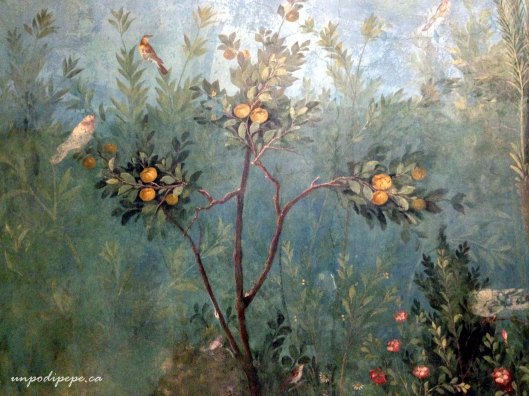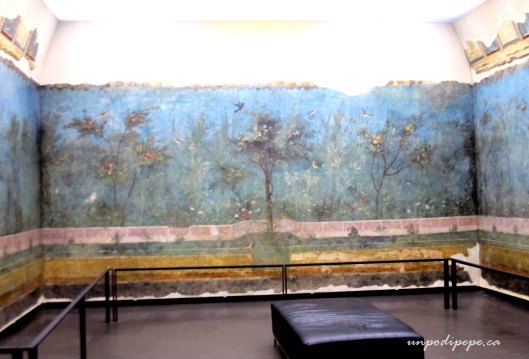Tags
Augustan Villa of the Farnesina, Musei Nazionale Romano, Palazzo Massimo alle Terme, Roma, Villa Livia
 One of the best museums in Roma is nascosto in piena vista. Hidden in plain sight near Stazione Termini, Palazzo Massimo alle Terme contains one of the most important collections of classical art. It is right across the street from Stazione Termini, visible from the bus loop on the way to Piazza dei Cinquecento. The first time I visited Palazzo Massimo was in 2006 when my friend who lives in Roma recommended it. There were only about 10 other people in the building!
One of the best museums in Roma is nascosto in piena vista. Hidden in plain sight near Stazione Termini, Palazzo Massimo alle Terme contains one of the most important collections of classical art. It is right across the street from Stazione Termini, visible from the bus loop on the way to Piazza dei Cinquecento. The first time I visited Palazzo Massimo was in 2006 when my friend who lives in Roma recommended it. There were only about 10 other people in the building!
When I was in Roma this summer, it was too hot to be out in the afternoon, so I decided to visit the museum. This turned out to be a great idea, since the top floor with the mosaics and detached frescos is downright cold! Brrrr! It was so refreshing! There were more than 10 people in the museum this time, but I still felt like I almost had the place to myself.
Built by Principe Massimiliano Massimo for the Jesuit Collegio Romano, the Palazzo became the first Liceo (high school) in Roma in 1871. Except for a brief period as a WWII military hospital,l the Liceo was open until 1960. In the 1980’s, in a state of neglect, it was purchased for the Museo Nazionale Romano. Renovations were completed in 1998. Palazzo Massimo is now 4 stories of classical amazingness. 700 years (200 BC to 500 AD) of Ancient Roman history, myths, artistic culture and everyday life are on display in the form of sculpture, fresco, mosaic, jewellery and coins.
What is extra cool about the artifacts in Palazzo Massimo is how they got to be there. Previous to the museum opening, most of this priceless stuff was in storage in the Roma city works yard! In a city as old as Roma, anywhere you break dirt, something will be found. During construction of the Metro, new roads, or any municipal work involving digging, artifacts were found, tagged and stored. Every piece in the museum has a sign with a written description in Italian and English. In between the two is stated (in Italiano only) precisely where and when it was found, and in some cases by whom. For example ‘Roma, Piazza Venezia, Construction of National Monument to Vittorio Emanuele II’, or ‘Subiaco, recovered by the Guardia di Finanza (revenue or tax police, involved in recovery of stolen artifacts)’. Reading these signs is exciting because you may have walked over that very spot the day before! Ok, maybe you won’t be as excited as me, but I am a total archeology geek so I find this fascinating!
The ground floor of Palazzo Massimo displays Greek originals discovered in Roma, such as The Dying Niobid, and the magnificent Pugile in riposo, the 2nd Century BC bronze Boxer at Rest, wearing leather hand wraps. He is so realistic with his broken nose, cuts and deformed ears, you can feel the emotion in his face.
This floor also has a Roman calendar, portraiture from the Republican and Imperial ages, and sarcophagi, such as the sarcophagus of Portonacci with battle scenes carved in relief.
The first floor (2nd floor to North Americans) has masterpieces of statuary, including the Maiden of Antium, Il Discobolo, a Crouching Aphrodite after Diodalses found at Villa Adriana in Tivoli in 1920, and the Sleeping Hermaphrodite. There are also all the surviving bronze sculptures, fittings and a head of Medusa that decorated Caligula’s floating palaces, the Nemi ships. These vessels were recovered in the 1920’s by draining Lago di Nemi, only to be destroyed by enemy fire in 1944.

Il Discobolo and a Crouching Aphrodite from Villa Adriana in Tivoli. Both are Roman reproductions of Greek originals
The top floor takes us on an intimate tour of the domestic decor inside Roman homes. An amazing discovery was made right across the street in 1947, during the renovations to Termini and construction of Metro line B. It was a complex from 130-140 AD built in a grid system of private homes, public baths, warehouses, and apartments with shops at street level. There was pavement and a functioning drainage system. It was all destroyed to make way for quick construction of the new buildings! Aaaahhh! Luckily the site was well-documented so that the 270 m² of wall frescos and pavement mosaics that were preserved could be reassembled. Part of it is displayed here where 3 rooms of a Domus (Roman house) have been reconstructed to their original size. Ironically, these rooms face a window looking out at where they used to be.

The 1948 photo from Palazzo Massimo of the site across the street. You can see that the mosaic is the same one that is now in the museum
The Augustan Villa of the Farnesina was discovered in Trastevere in 1879 during work along the river. The site has since been destroyed, but the vibrantly coloured frescoes were detached and stored for 120 years before being installed in Palazzo Massimo, in accurately reconstructed rooms of their original dimensions. There is a portico, dining room and 2 Vermillion coloured cubicola (bedrooms) with mythological and erotic paintings, and several hallways. The rooms are reassembled how they were, so it is like walking through a Roman villa. Decorating the walls of upper class houses with paintings of mythological or literary subjects was supposed to stimulate cultured conversation. In this villa, there are many references to the Egyptian world in the decorations, celebrating the conquest of Egypt. The owner is thought to have been General Marcus Vipsanius Agrippa, son-in-law of Augustus, who defeated Marc Anthony and Cleopatra at the Battle of Actium in 31 BC.
The final treasure is the 1st Century BC frescoes from Villa Livia, discovered on Via Flaminia in 1863. The villa belonged to Livia Drusilla, wife of Emperor Augustus. The paintings of a lush green garden with birds, pomegranate and lemon trees, roses, irises and other plants decorated a vaulted room that was half underground. The large room is recreated here. It was probably a cool triclinium, a living and dining room for the summer.  The basement has the history of the Roman Empire in coins. It has been converted into a vault for the Medagliere, the coin cabinet and jewellery.
The basement has the history of the Roman Empire in coins. It has been converted into a vault for the Medagliere, the coin cabinet and jewellery.
Palazzo Massimo is one of 4 musei that make up the Museo Nazionale Romano. Tickets are €7 for adults, valid for 3 days for all 4 sites. The other sites are: Terme di Diocleziano, Palazzo Altemps and Crypta Balbi. Open Tues to Sunday 0900-1945. If you love antiquities, don’t miss it! Ciao, Cristina



Pingback: Un Giorno a Roma | Un po' di pepe
Great post! I remember visiting this wonderful museum a number of years ago and having that same feeling of – where is everybody?
I guess they are all at the Vatican, waiting in line! Allora, Karen you are officially the first person, other than my friend Anna in Roma, who I’ve ‘met’ that has been to Palazzo Massimo! Same with Centrale Montemartini. I think the real problem is that no one actually spends enough time in Roma! Ciao, Cristina
That’s true – there’s so much to see and people figure that once they’ve seen the top 10 “recommended” sites, they’ve “done” Rome. But maybe it’s better that way, as it’s nice having a little elbow room every once and a while.
Cristina, I had no idea that’s what this big beautiful building was. Will definitely check it out when we are there this June,,,,thanks for sharing!!!!,
Prego! You will love it, especially if you spend a hot afternoon there!
Fantastic and informative post! Adding it to my “things to visit next time” list. Grazie from a fellow archaeology geek!
Grazie! Archeology geeks unite! Check out the post on Centrale Montemartini for another place to add to your list. Buona Domenica, Cristina
Love it .. excellent historic descriptions and super photos… ..Really enjoyed it
Grazie Susanne. I hope you get to visit in person some day soon. Ciao, Cristina
Pingback: Hairstyling in Ancient Roma | Un po' di pepe
Pingback: Buon Anno 2019 | Un po' di pepe
Pingback: Buon Anno 2020 | Un po' di pepe
Pingback: Beat the heat: Surviving Summer in Roma | Un po' di pepe
Pingback: Buon Anno 2023 | Un po' di pepe